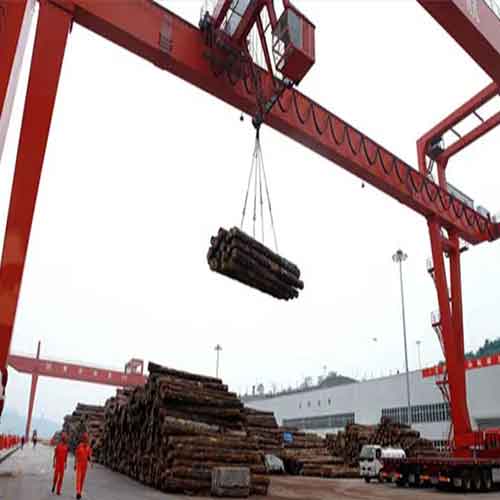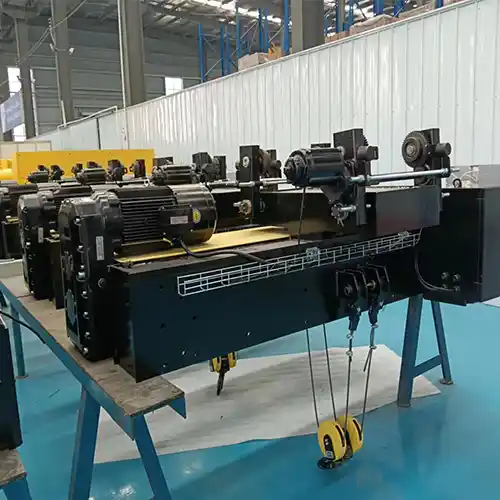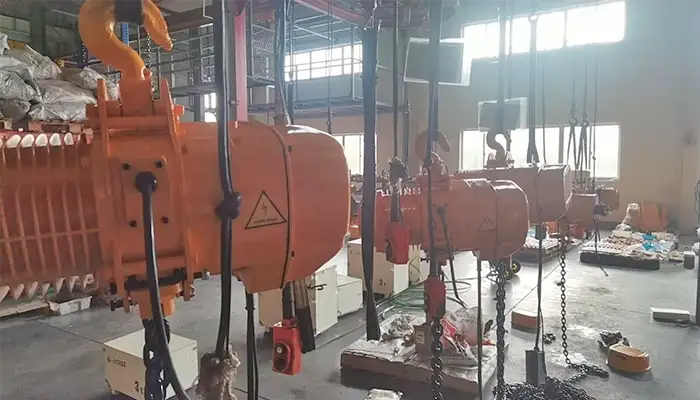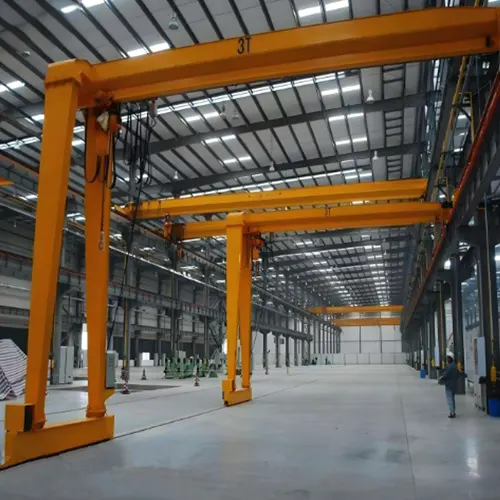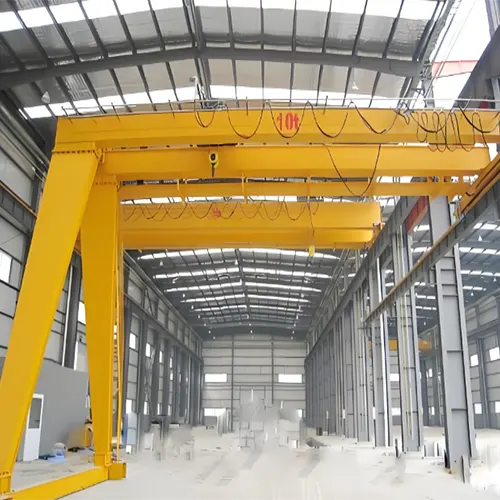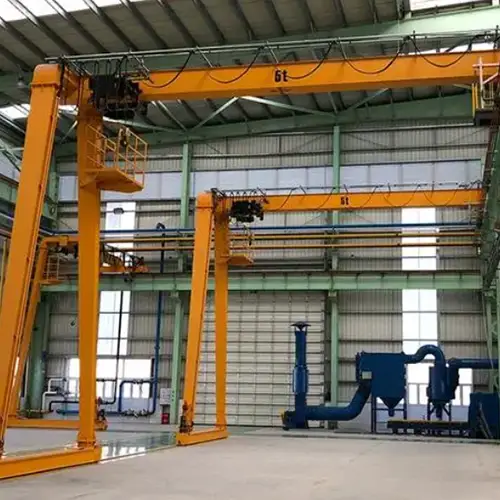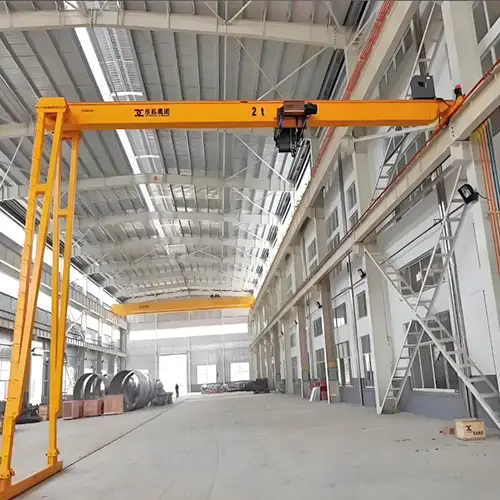Single Girder & Double Girder Gantry Cranes for Lumber Logistics
Lumber logistics benefit from single girder & double girder gantry crane, offering efficient & cost-effective solutions for handling & transporting lumber.
Category: Full& Half Gantry
Your Trusted Single Girder and Double Girder Gantry Crane Manufacturer & Supplier
Single Girder & Double Girder Gantry Cranes for Lumber Logistics
Lumber Logistics: Enhancing Operations with Single Girder Gantry Crane & Double Girder Gantry Crane Solutions
Lumber logistics benefit from single girder & double girder gantry crane, offering efficient & cost-effective solutions for handling & transporting lumber. In lumber yards, efficiency is key. Every operation, from loading and unloading to storage and transportation, needs to be optimized for maximum productivity. That's where single girder gantry cranes come in. These versatile machines are the workhorses of the lumber industry, helping businesses streamline their operations and stay ahead of the competition.
At their core, single girder gantry cranes are heavy-duty lifting machines designed to handle the rigors of lumber yard operations. Unlike traditional cranes, which have two parallel beams (or girders), single girder gantry cranes have just one. This design not only reduces weight and cost but also improves visibility and maneuverability, making them ideal for navigating the tight spaces often found in lumber yards.
The importance of single girder gantry cranes in lumber yard operations cannot be overstated. These machines are the backbone of efficiency, enabling businesses to move materials quickly and safely, even in the most challenging environments. Whether it's loading logs onto trucks, organizing lumber in storage areas, or transporting materials to processing stations, single girder gantry cranes get the job done with ease.
Types of Single Girder Gantry Crane for Lumber Yards
Single girder gantry cranes come in various configurations, each offering unique features and advantages for lumber yard operations. Let's explore the different types of single girder gantry cranes commonly used in lumber yards:
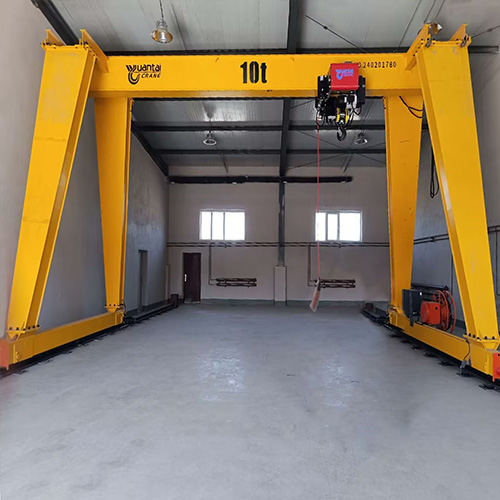
Box Type Single Girder Gantry Crane: This type of gantry crane features a box-shaped girder, providing exceptional strength and rigidity. It typically offers higher load capacities and longer spans compared to other types of cranes. Box type single girder gantry cranes are ideal for heavy-duty lifting tasks in lumber yards, such as handling large timber logs or bundles of lumber.

Truss Type Single Girder Gantry Crane:Truss type gantry cranes feature a lattice-like structure, offering a lightweight yet strong design. They are highly versatile and cost-effective, making them suitable for a wide range of applications. Truss type single girder gantry cranes are commonly used for general material handling tasks in lumber yards, including loading and unloading lumber products from trucks or railcars.

A-Frame Single Girder Gantry Crane: A-frame gantry cranes feature a simple yet sturdy design, with two vertical legs connected by a horizontal beam resembling the letter "A". They are easy to install and operate, making them suitable for smaller lumber yards or temporary job sites. A-frame single girder gantry cranes are often used for light to medium-duty lifting tasks in lumber yards, such as moving lumber bundles within the yard or loading materials onto trucks.

L-Leg Single Girder Gantry Crane: L-leg gantry cranes feature two vertical legs arranged in an "L" shape, providing stability and support for the crane structure. They offer a compact footprint and are suitable for indoor or outdoor applications with limited space. L-leg single girder gantry cranes are commonly used for precise material handling tasks in lumber yards, such as positioning lumber stacks or loading materials onto storage racks.
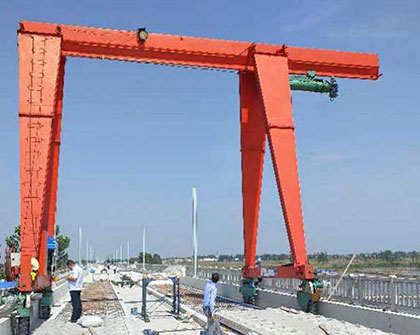
Rubber-Tired Single Girder Gantry Crane:
Rubber-tired gantry cranes (RTGs) are mobile cranes equipped with rubber tires, allowing them to move freely within the lumber yard without the need for fixed tracks or rails. They offer flexibility and maneuverability, making them suitable for dynamic work environments.Rubber-tired single girder gantry cranes are ideal for versatile material handling tasks in lumber yards, such as transporting lumber bundles between different areas or loading materials onto trucks for delivery.Each type of single girder gantry crane offers distinct features and advantages, catering to specific requirements and preferences in lumber yard operations. By choosing the right type of crane for their needs, lumber yards can optimize efficiency, productivity, and safety in their material handling processes.
Double Girder Gantry Cranes for Lumber Handling
Double girder gantry cranes are vital in the lumber logistics industry for their ability to handle large and heavy loads efficiently. Here are some common types used in lumber logistics:
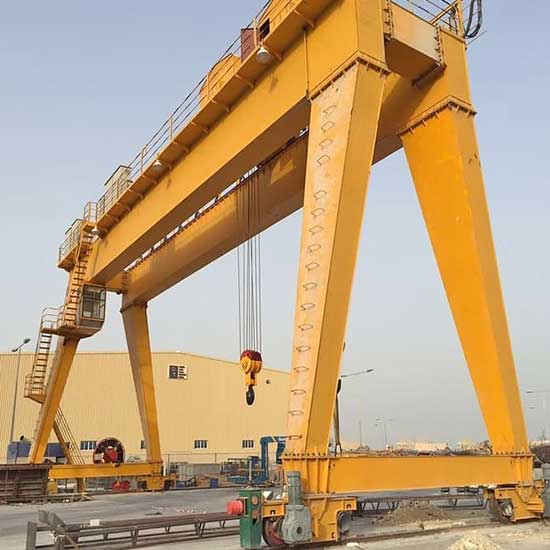
Rail-Mounted Double Girder Gantry Cranes: These cranes run on fixed rails embedded into the ground or on a raised track. Ideal for outdoor lumber yards where large areas need to be covered. High load capacity and stability, suitable for heavy-duty operations.
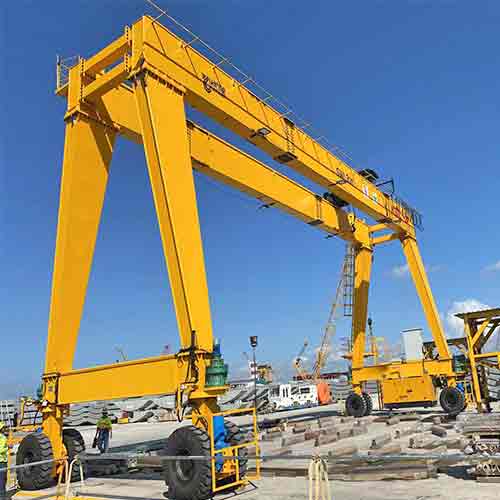
Rubber-Tired Double Girder Gantry Cranes: These cranes are mounted on rubber tires, allowing them to move freely around a facility. Suitable for operations requiring flexibility in movement within a lumber yard or between storage areas. Greater mobility compared to rail-mounted cranes, can operate on uneven surfaces.
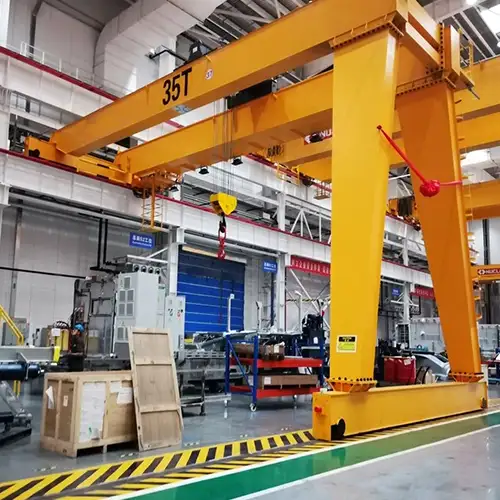
Semi-Gantry Double Girder Cranes: These have one side running on a ground rail and the other side on an elevated rail. Suitable for facilities where part of the crane needs to operate inside a building or under a structure. Flexible operation with part of the system integrated into existing structures.
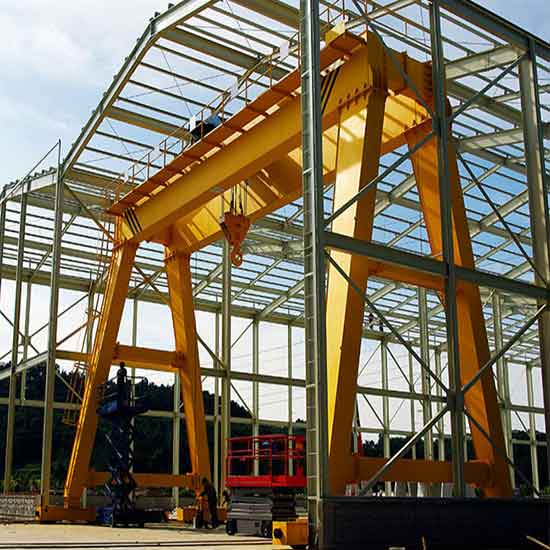
Overhead Double Girder Gantry Cranes: Similar to overhead cranes but with gantry support, allowing them to straddle a workspace. Suitable for indoor lumber processing facilities. Efficient space utilization, can cover large indoor areas without the need for support columns.
Each type of double girder gantry crane is designed to meet specific needs in lumber logistics, from heavy lifting and outdoor operations to flexible movement and indoor use. Selecting the right type depends on the specific requirements of the lumber handling operation, including load capacity, operational environment, and mobility needs.
Safety Features and Practices
Safety is paramount in any industrial setting, and lumber yards are no exception. Single girder gantry cranes come equipped with a range of essential safety mechanisms to ensure the well-being of both operators and materials. Let's delve into two key safety features: overload protection and emergency stop functions.
Essential Safety Mechanisms
Overload Protection
Overload protection is a crucial safety feature designed to prevent the crane from lifting loads beyond its rated capacity. In a busy lumber yard where heavy logs and lumber are being moved around constantly, it's essential to avoid overloading the crane, which could lead to equipment damage or, worse, accidents.
When the load on the crane exceeds the preset limit, the overload protection system kicks in, automatically stopping the lifting operation and alerting the operator. This ensures that the crane operates within its safe working limits, reducing the risk of equipment failure and ensuring the safety of personnel and materials.
Emergency Stop Functions
In the event of an emergency or unforeseen hazard, the crane must be able to come to a halt quickly and safely. That's where emergency stop functions come into play. These functions allow the operator to immediately stop all crane movements, including lifting, lowering, and traversing, with the push of a button or the activation of a switch.
By providing a rapid means of halting crane operations, emergency stop functions help mitigate risks and prevent accidents in high-pressure situations. Whether it's a sudden equipment malfunction, an obstruction in the crane's path, or an imminent safety threat, the ability to stop the crane at a moment's notice is essential for maintaining a safe working environment in the lumber yard.
In conclusion, the essential safety mechanisms of single girder gantry cranes, such as overload protection and emergency stop functions, play a vital role in ensuring the safety of operators and materials in lumber yard operations. By incorporating these features into their operations and adhering to best safety practices, lumber yard operators can minimize risks and maintain a secure working environment for all personnel involved.
Operator Training and Safety Practices
Ensuring the safety of lumber yard operations goes beyond the crane's built-in safety features—it also relies heavily on the expertise and vigilance of crane operators. Here, we'll explore the importance of operator training and safety practices, focusing on operator certification and safe load handling techniques.
Operator Certification
One of the most critical aspects of crane safety is the competence of the operator. Operators must undergo comprehensive training and certification programs to ensure they possess the necessary skills and knowledge to operate the crane safely and effectively.
Operator certification programs typically cover a range of topics, including crane operation fundamentals, equipment maintenance, load capacity calculations, and emergency procedures. Through a combination of classroom instruction, hands-on training, and practical assessments, operators learn how to operate the crane safely, identify potential hazards, and respond appropriately to emergencies.
By obtaining certification, operators demonstrate their commitment to safety and professionalism, instilling confidence in their ability to operate the crane responsibly and minimize risks in the lumber yard environment.
Safe Load Handling Techniques
In addition to operator certification, it's essential for crane operators to understand and adhere to safe load handling techniques. Proper load handling not only prevents accidents and equipment damage but also ensures the efficient and effective movement of materials in the lumber yard.
Some key safe load handling techniques include:
- Ensuring loads are properly secured and balanced before lifting.
- Avoiding sudden or jerky movements when lifting or lowering loads.
- Maintaining a safe distance from overhead obstacles and other equipment.
- Using appropriate lifting accessories, such as slings or hooks, to secure loads.
- Communicating effectively with ground personnel to coordinate lifting operations safely.
In summary, operator training and safety practices are essential components of ensuring crane safety in lumber yard operations. By investing in comprehensive training programs and promoting adherence to safe load handling techniques, lumber yard operators can maintain a safe working environment and mitigate risks associated with crane operations.
Load Capacity and Handling

Crane Load Capacity
Understanding the load capacity of a single girder gantry crane is crucial for safe and efficient operations in lumber yards. Let's delve into two key aspects of crane load capacity: maximum weight capacity and load distribution considerations.
Maximum Weight Capacity
The maximum weight capacity of a crane refers to the maximum amount of weight it can safely lift and transport. In lumber yard operations, where heavy logs and lumber are commonplace, knowing the crane's maximum weight capacity is essential for preventing overloading and ensuring the safety of personnel and materials.
Single girder gantry cranes typically have a maximum weight capacity ranging from a few tons to several dozen tons, depending on factors such as the crane's size, design, and structural integrity. It's imperative for operators to be aware of and adhere to the crane's maximum weight capacity to avoid equipment damage and accidents.
Load Distribution Considerations
In addition to knowing the crane's maximum weight capacity, operators must also consider load distribution when handling materials in the lumber yard. Uneven load distribution can result in instability, tipping, or structural damage to the crane, posing safety risks to personnel and materials.
Proper load distribution involves evenly distributing the weight of the load across the crane's lifting mechanism, such as the hoist or lifting hook. Operators must ensure that the load is properly centered and balanced to prevent overloading of individual components and maintain stability during lifting and transportation.
Factors to consider when assessing load distribution include the shape, size, and weight distribution of the load, as well as the crane's lifting capacity and structural limitations. By carefully evaluating these factors and adhering to best practices for load distribution, operators can minimize the risk of accidents and ensure the safe and efficient handling of materials in the lumber yard.
In summary, understanding crane load capacity and load distribution considerations is essential for safe and efficient operations in lumber yards. By knowing the crane's maximum weight capacity and adhering to proper load distribution techniques, operators can prevent accidents, protect valuable materials, and optimize the efficiency of crane operations in the lumber yard environment.
Efficient Handling Techniques
Efficient handling of logs and lumber is the hallmark of a well-operated lumber yard. Here, we'll explore two key techniques for maximizing efficiency in material handling: maneuvering heavy logs and lumber, and precision placement of materials.
Maneuvering Heavy Logs and Lumber
In lumber yards, heavy logs and lumber are a common sight, and maneuvering them safely and efficiently is essential for maintaining productivity. Single girder gantry cranes are designed to handle heavy loads, but proper technique is crucial to prevent accidents and damage to materials.
When maneuvering heavy logs and lumber, operators should:
- Use slow, controlled movements to minimize swinging and ensure stability.
- Keep the load close to the ground during horizontal movements to maintain stability and reduce the risk of tipping.
- Avoid sudden starts and stops to prevent jolting and shifting of the load.
- Maintain clear communication with ground personnel to coordinate movements and ensure safe positioning of materials.
By employing these techniques, operators can safely navigate the lumber yard environment and transport heavy logs and lumber with precision and efficiency.
Precision Placement of Materials
Precision placement of materials is essential for optimizing storage space and facilitating downstream production processes. Whether stacking lumber bundles or arranging logs for processing, precise placement ensures efficient use of available space and minimizes the need for rework or rearrangement.
Operators should:
- Position materials with care to ensure they are stacked securely and evenly.
- Utilize the crane's controls to adjust the height and angle of the load for precise placement.
- Maintain clear sightlines to the designated storage area or processing station to ensure accurate positioning.
- Monitor load weight and distribution to prevent overloading or imbalance during placement.
By focusing on precision placement, operators can streamline workflow processes, minimize material handling errors, and maximize the efficiency of lumber yard operations.
In summary, efficient handling techniques, such as maneuvering heavy logs and lumber and precision placement of materials, are essential for maximizing productivity and safety in lumber yards. By employing proper techniques and adhering to best practices, operators can optimize material handling processes, minimize downtime, and enhance overall efficiency in the lumber yard environment.
Space Optimization Strategies
Layout Planning for Lumber Yards
Efficient layout planning is crucial for maximizing space utilization and optimizing crane positioning in lumber yards. Let's explore two key strategies for effective layout planning:
Maximizing Space Utilization
In lumber yards, space is often at a premium, and every square meter counts. Maximizing space utilization involves strategically organizing the layout of the yard to make the most efficient use of available space.
Some effective strategies for maximizing space utilization include:
- Implementing a grid-based layout to organize materials systematically and minimize wasted space.
- Utilizing vertical storage solutions, such as racks or shelves, to capitalize on unused overhead space.
- Consolidating similar materials and products to reduce clutter and free up valuable floor space.
- Designating clear pathways and traffic lanes to facilitate the movement of materials and equipment without impeding workflow.
By optimizing the layout of the lumber yard to prioritize space utilization, operators can enhance efficiency, streamline material handling processes, and accommodate future growth and expansion.
Optimizing Crane Positioning
The positioning of single girder gantry cranes plays a critical role in optimizing material handling efficiency and workflow in lumber yards. Proper crane positioning ensures optimal coverage of the yard and minimizes travel distances, reducing the time and effort required to transport materials.
Key considerations for optimizing crane positioning include:
- Placing cranes strategically at key points throughout the yard to minimize travel distances and maximize coverage.
- Aligning crane positioning with the layout of storage areas, processing stations, and transportation routes to facilitate seamless material flow.
- Considering factors such as load size, weight, and frequency of handling when determining crane placement to ensure efficient operation.
- Allowing for sufficient clearance and maneuvering space around cranes to accommodate safe and effective material handling operations.
By carefully planning and optimizing crane positioning in conjunction with the layout of the lumber yard, operators can improve material handling efficiency, reduce congestion, and enhance overall productivity.
In summary, effective layout planning is essential for maximizing space utilization and optimizing crane positioning in lumber yards. By implementing strategies to maximize space utilization and strategically position cranes, operators can streamline material handling processes, improve workflow efficiency, and maximize the productivity of the lumber yard environment.
Vertical Space Management
In lumber yards, making the most of vertical space is crucial for efficient storage and material handling. Here, we'll explore two key techniques for effective vertical space management:
Utilizing Height Clearance for Storage
Vertical space is often underutilized in lumber yards, but it presents a valuable opportunity for maximizing storage capacity without expanding the footprint of the facility. By utilizing height clearance for storage, operators can significantly increase the amount of material that can be stored on-site.
Some effective strategies for utilizing height clearance for storage include:
- Implementing tall shelving or racking systems to stack materials vertically.
- Using stackable containers or crates to store smaller items and maximize vertical storage space.
- Installing mezzanine floors or elevated platforms to create additional storage levels above ground level.
- Incorporating overhead cranes or hoists for lifting and transporting materials to higher storage areas.
By taking advantage of height clearance for storage, operators can optimize storage capacity, reduce clutter on the ground level, and create a more organized and efficient lumber yard environment.
Multi-Level Material Handling Solutions
Multi-level material handling solutions enable operators to efficiently move materials between different levels of the lumber yard, streamlining workflow and maximizing productivity. These solutions typically involve the use of elevators, conveyors, or automated transfer systems to transport materials vertically.
Key benefits of multi-level material handling solutions include:
- Reducing the need for manual lifting and carrying of materials between levels, minimizing labor requirements and improving safety.
- Facilitating efficient transfer of materials between storage areas, processing stations, and transportation routes, optimizing workflow and minimizing downtime.
- Maximizing the use of available vertical space in the lumber yard, allowing operators to store more materials in a smaller footprint.
- Enhancing overall material handling efficiency and throughput, leading to improved productivity and profitability.
By implementing multi-level material handling solutions, operators can unlock the full potential of vertical space in the lumber yard, optimize material flow, and achieve greater efficiency and cost-effectiveness in their operations.
In summary, effective vertical space management is essential for maximizing storage capacity and optimizing material handling efficiency in lumber yards. By utilizing height clearance for storage and implementing multi-level material handling solutions, operators can make the most of available space, streamline workflow, and enhance overall productivity in the lumber yard environment.
Technological Advancements
Automation and Remote Monitoring
As technology continues to evolve, so do the capabilities of single girder gantry cranes in lumber yards. Here, we'll explore two significant technological advancements: automated crane operation and remote monitoring systems.
Automated Crane Operation
Automation has revolutionized the way cranes operate in lumber yards, with automated crane operation systems taking on tasks that were once performed manually. Automated crane operation systems use sensors, cameras, and computer algorithms to control crane movements and perform lifting operations with precision and efficiency.
Key features of automated crane operation systems include:
- Pre-programmed lift sequences: Cranes can be programmed to perform specific lift sequences automatically, reducing the need for manual intervention and streamlining repetitive tasks.
- Collision avoidance systems: Sensors and cameras detect obstacles in the crane's path and automatically adjust its trajectory to avoid collisions, minimizing the risk of accidents and equipment damage.
- Load sensing technology: Advanced load sensing technology enables cranes to detect the weight and center of gravity of the load and adjust their lifting parameters accordingly, ensuring safe and efficient material handling.
By leveraging automated crane operation systems, lumber yards can increase productivity, reduce labor costs, and improve safety by minimizing human error and enhancing operational efficiency.
Remote Monitoring Systems
Remote monitoring systems enable operators to monitor crane performance and status remotely, providing real-time insights into crane operations and maintenance needs. These systems use sensors and wireless communication technology to collect data on crane performance, health, and usage, which can be accessed and analyzed from a centralized location.
Key benefits of remote monitoring systems include:
- Predictive maintenance: By monitoring key performance indicators such as motor temperature, hydraulic pressure, and brake wear, remote monitoring systems can identify potential issues before they escalate into major problems, enabling proactive maintenance and minimizing downtime.
- Operational efficiency: Real-time monitoring of crane usage and performance allows operators to optimize crane operations, identify inefficiencies, and make data-driven decisions to improve productivity and reduce operating costs.
- Enhanced safety: Remote monitoring systems provide operators with instant access to critical safety information, such as load weight, crane position, and environmental conditions, enabling them to respond quickly to potential safety hazards and mitigate risks.
By implementing remote monitoring systems, lumber yards can enhance crane performance, prolong equipment lifespan, and improve overall operational efficiency and safety.
In summary, technological advancements such as automated crane operation and remote monitoring systems are transforming the capabilities of single girder gantry cranes in lumber yards. By embracing these advancements, operators can increase productivity, improve safety, and optimize efficiency in their material handling operations.
Predictive Maintenance
Predictive maintenance is revolutionizing the way single girder gantry cranes are maintained in lumber yards. By leveraging advanced condition monitoring technologies and proactive maintenance strategies, operators can ensure optimal crane performance and minimize downtime.
Condition Monitoring Technologies
Condition monitoring technologies enable operators to assess the health and performance of cranes in real-time, allowing for early detection of potential issues and proactive maintenance interventions. Some common condition monitoring technologies used in single girder gantry cranes include:
- Vibration analysis: By monitoring vibrations in crane components such as motors, gears, and bearings, operators can identify abnormal patterns that may indicate wear, misalignment, or other mechanical issues.
- Oil analysis: Regular analysis of crane lubricants can reveal signs of contamination, degradation, or excessive wear in critical components, providing insights into the overall health of the crane.
- Thermal imaging: Thermal imaging cameras can detect hot spots in crane components caused by friction, electrical resistance, or other sources of heat, signaling potential issues such as overheating or electrical faults.
- Remote diagnostics: Remote monitoring systems allow operators to access real-time data on crane performance and condition from a centralized location, enabling early detection of abnormalities and timely intervention.
By leveraging condition monitoring technologies, operators can identify potential maintenance needs before they escalate into major problems, minimizing downtime and optimizing crane reliability and performance.
Proactive Maintenance Strategies
In addition to condition monitoring, proactive maintenance strategies play a crucial role in ensuring the longevity and reliability of single girder gantry cranes. Proactive maintenance involves regular inspections, preventive maintenance tasks, and planned repairs aimed at addressing potential issues before they impact crane performance.
Some proactive maintenance strategies include:
- Regular inspections: Conducting routine inspections of crane components, such as hoists, trolleys, and structural elements, to identify signs of wear, damage, or corrosion.
- Scheduled maintenance: Implementing a proactive maintenance schedule based on manufacturer recommendations and industry best practices, including lubrication, adjustments, and component replacements as needed.
- Predictive analytics: Using data-driven analytics to forecast maintenance needs and prioritize maintenance activities based on equipment condition, usage patterns, and historical performance data.
By adopting proactive maintenance strategies, operators can minimize the risk of unexpected breakdowns, extend the lifespan of crane components, and optimize overall equipment reliability and availability.
In summary, predictive maintenance technologies and proactive maintenance strategies are essential for ensuring optimal performance and reliability of single girder gantry cranes in lumber yards. By leveraging advanced condition monitoring technologies and proactive maintenance practices, operators can minimize downtime, reduce maintenance costs, and maximize the efficiency and longevity of their crane assets.
Environmental Considerations
Energy Efficiency
In today's world, environmental sustainability is a top priority for businesses across all industries, including lumber yards. Single girder gantry cranes can contribute to environmental conservation through energy-efficient design and operation. Let's explore two key aspects of energy efficiency: eco-friendly power sources and energy-saving features.
Eco-Friendly Power Sources
Utilizing eco-friendly power sources is a significant step towards reducing the environmental impact of crane operations in lumber yards. By transitioning to renewable energy sources such as solar, wind, or hydroelectric power, operators can minimize greenhouse gas emissions and reduce reliance on fossil fuels.
Some benefits of eco-friendly power sources include:
- Reduced carbon footprint: Renewable energy sources produce little to no greenhouse gas emissions during operation, helping to mitigate climate change and minimize environmental pollution.
- Energy independence: By generating their own clean energy on-site, lumber yards can reduce their dependence on fossil fuels and volatile energy markets, enhancing energy security and resilience.
- Cost savings: While the initial investment in renewable energy infrastructure may be significant, the long-term cost savings from reduced energy bills and potential incentives or rebates can outweigh the upfront costs.
By harnessing the power of renewable energy sources, lumber yards can demonstrate their commitment to environmental sustainability and contribute to a cleaner, greener future.
Energy-Saving Features
In addition to utilizing eco-friendly power sources, single girder gantry cranes can incorporate energy-saving features to minimize energy consumption during operation. These features may include:
- Variable frequency drives (VFDs): VFDs adjust the speed of crane motors based on the load and application requirements, reducing energy consumption and minimizing wasted energy.
- Regenerative braking systems: Regenerative braking systems capture and store energy generated during braking and deceleration events, which can be reused to power other crane functions or fed back into the grid.
- LED lighting: LED lighting fixtures consume less energy than traditional lighting systems and have a longer lifespan, reducing maintenance costs and minimizing environmental impact.
- Energy-efficient motors: High-efficiency electric motors are designed to minimize energy losses and optimize performance, resulting in lower energy consumption and reduced operating costs.
By incorporating energy-saving features into crane design and operation, lumber yards can achieve significant reductions in energy consumption, lower operating costs, and demonstrate their commitment to environmental stewardship.
In summary, energy efficiency is a critical consideration for single girder gantry cranes in lumber yards. By leveraging eco-friendly power sources and incorporating energy-saving features into crane design and operation, operators can minimize their environmental footprint, reduce operating costs, and contribute to a more sustainable future.
Emissions Reduction
Reducing emissions is a key aspect of environmental sustainability in lumber yard operations. Single girder gantry cranes can play a significant role in emissions reduction through the adoption of low-emission crane technologies and the implementation of environmental impact assessments.
Low-Emission Crane Technologies
Low-emission crane technologies focus on minimizing the environmental impact of crane operations by reducing emissions of pollutants such as carbon dioxide (CO2), nitrogen oxides (NOx), and particulate matter. Some key low-emission crane technologies include:
- Electric powertrains: Electric-powered cranes produce zero emissions at the point of use, making them a cleaner alternative to diesel-powered cranes. By using electricity from renewable sources, such as solar or wind power, operators can further reduce emissions associated with crane operations.
- Hybrid power systems: Hybrid cranes combine multiple power sources, such as diesel engines and electric motors, to optimize fuel efficiency and minimize emissions. These systems can automatically switch between power sources based on load and application requirements, reducing fuel consumption and emissions during operation.
- Exhaust aftertreatment systems: Exhaust aftertreatment systems, such as selective catalytic reduction (SCR) and diesel particulate filters (DPF), can reduce emissions of harmful pollutants from diesel-powered cranes by removing or neutralizing them before they are released into the atmosphere.
By investing in low-emission crane technologies, lumber yards can reduce their environmental footprint, improve air quality, and contribute to global efforts to combat climate change.
Environmental Impact Assessments
Environmental impact assessments are essential tools for identifying and mitigating the environmental impacts of crane operations in lumber yards. These assessments evaluate the potential effects of crane operations on air quality, water quality, wildlife habitats, and other environmental factors, helping operators make informed decisions to minimize negative impacts.
Key components of environmental impact assessments may include:
- Air quality monitoring: Assessing emissions of pollutants such as NOx, SOx, and particulate matter from crane operations and identifying measures to minimize air pollution.
- Water quality monitoring: Evaluating the potential for crane operations to contaminate water bodies through runoff or discharge of pollutants and implementing measures to protect water quality.
- Habitat assessments: Surveying the local ecosystem to identify sensitive habitats or species that may be affected by crane operations and developing strategies to mitigate impacts, such as habitat restoration or wildlife conservation measures.
By conducting thorough environmental impact assessments, lumber yards can identify potential environmental risks and implement proactive measures to minimize their impact on the surrounding environment, ensuring sustainable crane operations for years to come.
In summary, emissions reduction is a critical component of environmental sustainability in lumber yard operations. By adopting low-emission crane technologies and conducting comprehensive environmental impact assessments, operators can minimize their environmental footprint, protect natural resources, and promote a healthier planet for future generations.
Integration with Production Processes
Sawmilling and Processing Operations
Integrating single girder gantry cranes with sawmilling and processing operations is essential for maximizing efficiency and streamlining production workflows in lumber yards. Let's explore two key aspects of this integration: integration with sawmills and planers, and streamlining production workflow.
Integration with Sawmills and Planers
Sawmills and planers are central to lumber yard operations, where raw logs are processed into finished lumber products. Single girder gantry cranes play a vital role in these operations by facilitating the movement of materials between different stages of the production process.

Key considerations for integrating cranes with sawmills and planers include:
- Material handling: Cranes are used to transport raw logs from storage areas to the sawmill or planer, where they are processed into lumber. Once processed, cranes can then move the finished lumber to storage or shipping areas for distribution.
- Loading and unloading: Cranes are used to load and unload logs and lumber onto processing equipment, such as saws and planers, as well as onto trucks or railcars for transportation to customers.
- Positioning and manipulation: Cranes are equipped with specialized attachments, such as grabs or clamps, for securely gripping and positioning logs and lumber during processing operations, ensuring precise and efficient material handling.
By integrating cranes with sawmills and planers, lumber yards can optimize material flow, reduce processing times, and increase overall productivity.
Streamlining Production Workflow
Streamlining production workflow is essential for maximizing efficiency and minimizing downtime in lumber yard operations. Single girder gantry cranes can play a key role in streamlining production workflows by providing efficient and reliable material handling solutions.
Some strategies for streamlining production workflow with cranes include:
- Just-in-time delivery: Cranes can be used to transport materials to processing stations as needed, minimizing the need for storage space and reducing the risk of material damage or spoilage.
- Automated material handling: Cranes equipped with automated operation systems can perform repetitive material handling tasks with precision and efficiency, freeing up labor resources for more complex or specialized tasks.
- Workflow optimization: By analyzing production workflows and identifying bottlenecks or inefficiencies, operators can optimize crane operations to minimize idle time and maximize throughput.
By streamlining production workflow with cranes, lumber yards can improve overall efficiency, reduce operating costs, and enhance competitiveness in the marketplace.
In summary, integrating single girder gantry cranes with sawmilling and processing operations is essential for maximizing efficiency and streamlining production workflows in lumber yards. By optimizing material handling processes and streamlining production workflow, operators can enhance productivity, reduce costs, and maintain a competitive edge in the industry.
Packaging and Shipping
Efficient packaging and shipping are crucial aspects of lumber yard operations, and single girder gantry cranes play a vital role in these processes. Let's delve into two key components of integration with packaging and shipping: efficient packaging solutions and loading and unloading procedures.
Efficient Packaging Solutions
Efficient packaging solutions are essential for protecting lumber products during transit and maximizing space utilization in shipping containers or trucks. Single girder gantry cranes contribute to efficient packaging by providing precise and controlled material handling capabilities.
Some efficient packaging solutions facilitated by gantry cranes include:
- Bundle wrapping: Cranes can efficiently bundle lumber products together using straps or wraps, ensuring they remain secure during transportation and minimizing the risk of damage.
- Palletizing: Cranes can stack lumber products onto pallets in an organized manner, optimizing space utilization and facilitating easier handling during loading and unloading.
- Custom packaging: Cranes equipped with specialized attachments can handle a variety of packaging materials, such as shrink wrap or stretch film, to protect lumber products from moisture, dust, and other environmental factors.
By utilizing efficient packaging solutions facilitated by gantry cranes, lumber yards can reduce material waste, minimize transportation costs, and enhance customer satisfaction through the delivery of intact and well-protected products.
Loading and Unloading Procedures
Loading and unloading procedures are critical stages in the shipping process, and efficient handling of lumber products is essential to minimize turnaround times and ensure on-time delivery. Gantry cranes play a key role in loading and unloading procedures by providing fast and reliable material handling capabilities.
Key considerations for loading and unloading procedures with gantry cranes include:
- Efficient loading: Cranes can swiftly load lumber products onto trucks or shipping containers, optimizing space utilization and minimizing loading times.
- Safe handling: Gantry cranes are equipped with safety features such as overload protection and precision controls, ensuring safe and secure handling of lumber products during loading and unloading operations.
- Streamlined processes: By integrating gantry cranes with other shipping equipment, such as conveyor belts or loading docks, operators can streamline loading and unloading procedures, minimizing downtime and maximizing throughput.
By implementing efficient loading and unloading procedures with gantry cranes, lumber yards can improve operational efficiency, reduce transportation costs, and enhance customer satisfaction through timely deliveries.
In summary, integration of single girder gantry cranes with packaging and shipping processes is essential for optimizing efficiency and ensuring the timely delivery of lumber products. By utilizing efficient packaging solutions and streamlining loading and unloading procedures with gantry cranes, lumber yards can enhance productivity, reduce costs, and maintain a competitive edge in the marketplace.
Cost Analysis and Return on Investment
Initial Investment Costs
Before implementing single girder gantry cranes in lumber yards, it's crucial to evaluate the initial investment costs involved. This includes expenses related to crane procurement, installation, and setup.
Crane Procurement Expenses
The procurement of single girder gantry cranes involves several costs, including:
- Crane unit cost: The upfront cost of purchasing the crane, which varies based on factors such as capacity, span, lifting height, and manufacturer.
- Optional features: Additional features or customization options, such as automated operation systems, remote monitoring capabilities, or specialized attachments, may incur extra costs.
- Shipping and handling: Expenses associated with transporting the crane components from the manufacturer to the lumber yard location.
When evaluating crane procurement expenses, it's essential to consider the total cost of ownership, including both upfront costs and long-term operational expenses.
Installation and Setup Costs
In addition to crane procurement expenses, there are costs associated with installing and setting up the crane at the lumber yard location. These costs may include:
- Site preparation: Expenses related to preparing the site for crane installation, such as clearing obstacles, leveling the ground, and pouring concrete foundations.
- Crane assembly: Labor and equipment costs for assembling the crane components and installing them according to manufacturer specifications.
- Electrical and infrastructure upgrades: Costs associated with installing power lines, control systems, and other infrastructure necessary for crane operation.
Proper installation and setup are critical for ensuring the safe and efficient operation of single girder gantry cranes in lumber yards.
By carefully evaluating initial investment costs, lumber yard operators can make informed decisions about the feasibility and potential return on investment of implementing single girder gantry cranes in their operations.

Cost Analysis and Return on Investment
Initial Investment Costs
Before integrating single girder gantry cranes into lumber yard operations, it's crucial to conduct a thorough cost analysis to assess the initial investment required. This section will explore two primary components of initial investment costs: crane procurement expenses and installation/setup costs.
Crane Procurement Expenses
The procurement of single girder gantry cranes constitutes a significant portion of the initial investment costs. Several factors contribute to the total expenses associated with crane procurement, including:
- Crane type and specifications: The cost of the crane depends on its capacity, span, lifting height, and additional features. Higher capacity cranes with longer spans and greater lifting heights typically incur higher procurement expenses.
- Quality and reliability: Investing in high-quality cranes from reputable manufacturers may entail higher upfront costs but can result in greater reliability, durability, and long-term cost savings.
- Customization options: Customization of cranes to meet specific operational requirements may incur additional expenses. Custom features such as specialized attachments, automation systems, or safety enhancements can impact procurement costs.
- Warranty and service agreements: Consideration of warranty coverage and service agreements is essential when evaluating crane procurement expenses. Opting for extended warranties or comprehensive service contracts may involve additional upfront costs but can provide peace of mind and long-term savings on maintenance and repairs.
By carefully assessing these factors and comparing quotes from multiple suppliers, lumber yards can make informed decisions to optimize crane procurement expenses and ensure value for money.
Installation and Setup Costs
In addition to crane procurement expenses, installation and setup costs are another significant component of the initial investment required for integrating single girder gantry cranes into lumber yard operations. Installation and setup costs may include:
- Site preparation: Preparing the site for crane installation, including leveling the ground, pouring concrete foundations, and installing rail tracks or support structures, can incur expenses.
- Crane assembly and installation: Costs associated with crane assembly, rigging, and installation by qualified technicians or contractors.
- Electrical and utility connections: Expenses related to electrical wiring, power supply connections, and utility hookups required to operate the crane efficiently.
- Safety equipment and compliance: Investment in safety equipment, such as fencing, signage, and safety barriers, to ensure compliance with regulatory requirements and enhance workplace safety.
By budgeting for installation and setup costs upfront and working with experienced contractors, lumber yards can streamline the installation process and minimize the risk of delays or cost overruns.
In summary, conducting a comprehensive cost analysis of initial investment expenses, including crane procurement and installation/setup costs, is essential for making informed decisions and maximizing the return on investment in single girder gantry cranes for lumber yard operations. By carefully evaluating procurement options, minimizing installation expenses, and planning for potential contingencies, lumber yards can optimize their investment in crane technology and achieve long-term cost savings and operational efficiency.
Regulatory Compliance and Standards
Regulatory Requirements
Compliance with regulatory requirements and standards is paramount in ensuring the safe and environmentally responsible operation of single girder gantry cranes in lumber yards. This section addresses two key aspects of regulatory compliance: safety regulations and standards, and environmental compliance.
Safety Regulations and Standards
Adherence to safety regulations and standards is essential to prevent accidents, protect workers, and maintain a safe working environment in lumber yards. Key safety regulations and standards governing the operation of single girder gantry cranes include:
- Occupational Safety and Health Administration (OSHA) regulations: OSHA sets forth safety standards for crane operations, including requirements for crane inspection, maintenance, and operator training.
- American National Standards Institute (ANSI) standards: ANSI publishes standards for the design, construction, and operation of overhead and gantry cranes, outlining requirements for structural integrity, load capacities, and safety features.
- International Organization for Standardization (ISO) standards: ISO develops international standards for crane design, performance, and safety, providing guidelines for manufacturers, operators, and regulatory authorities worldwide.
By complying with these safety regulations and standards, lumber yards can mitigate risks, prevent accidents, and ensure the well-being of workers and equipment.
Environmental Compliance
In addition to safety regulations, lumber yards must also comply with environmental regulations to minimize their impact on the surrounding ecosystem and natural resources. Key environmental compliance considerations for single girder gantry cranes include:
- Air quality regulations: Regulations governing emissions of pollutants such as particulate matter, nitrogen oxides, and volatile organic compounds from crane operations.
- Water quality regulations: Regulations governing discharge of wastewater or runoff from crane operations into water bodies, including requirements for containment and treatment of contaminants.
- Habitat protection regulations: Regulations aimed at protecting sensitive habitats and species that may be impacted by crane operations, such as wetlands, forests, or endangered wildlife habitats.
By adhering to environmental compliance requirements, lumber yards can demonstrate their commitment to sustainability, minimize environmental risks, and maintain good relationships with regulatory authorities and local communities.
In summary, regulatory compliance is a critical consideration for the operation of single girder gantry cranes in lumber yards. By ensuring compliance with safety regulations and standards, as well as environmental regulations, operators can promote a safe and environmentally responsible workplace, minimize risks, and uphold their legal and ethical responsibilities.
Certification and Inspections
Certification and inspections play a vital role in ensuring that single girder gantry cranes in lumber yards meet regulatory requirements and operate safely. This section explores two essential aspects: CE Certification and OSHA Compliance.
 CE certificate of gantry cranes, single girder gantry cranes , double girder gantry cranes and semi gantry cranes
CE certificate of gantry cranes, single girder gantry cranes , double girder gantry cranes and semi gantry cranes CE Certification
CE Certification is a mandatory conformity marking for products sold within the European Economic Area (EEA) and indicates compliance with EU safety, health, and environmental protection requirements. For single girder gantry cranes operating in lumber yards, obtaining CE Certification demonstrates adherence to stringent safety standards and ensures the protection of workers and equipment.
Key aspects of CE Certification for single girder gantry cranes include:
- Structural integrity: Ensuring that the crane's design, construction, and materials meet the requirements outlined in relevant European standards, such as EN 13001 for crane design and EN 15011 for crane safety.
- Electrical safety: Verifying that electrical components and systems comply with applicable EU directives, such as the Low Voltage Directive (2014/35/EU) and the Machinery Directive (2006/42/EC).
- Documentation and marking: Providing comprehensive documentation, including technical files, user manuals, and risk assessments, and affixing the CE Marking to the crane to indicate compliance with EU regulations.
By obtaining CE Certification, lumber yards can demonstrate their commitment to quality and safety, enhance market competitiveness, and gain access to markets within the European Union.
OSHA Compliance
Compliance with Occupational Safety and Health Administration (OSHA) regulations is essential for ensuring the safe operation of single girder gantry cranes in lumber yards, particularly in the United States. OSHA sets forth regulations and standards aimed at protecting workers from hazards associated with crane operations and ensuring a safe working environment.
Key aspects of OSHA Compliance for single girder gantry cranes include:
- Crane inspection and maintenance: Conducting regular inspections of cranes and lifting equipment to identify and address potential hazards or defects, in accordance with OSHA standards outlined in 29 CFR 1910.179.
- Operator training and certification: Providing comprehensive training programs for crane operators to ensure competency in safe crane operation, as required by OSHA's Crane and Derrick Standard (29 CFR 1926.1427).
- Safety measures and procedures: Implementing safety measures such as emergency stop devices, warning signs, and operational procedures to prevent accidents and ensure compliance with OSHA regulations.
By complying with OSHA regulations, lumber yards can protect workers from workplace injuries, avoid costly penalties and fines, and maintain a positive reputation for safety and compliance.
In summary, certification and inspections are essential for ensuring the safe and compliant operation of single girder gantry cranes in lumber yards. By obtaining CE Certification and adhering to OSHA Compliance requirements, operators can demonstrate their commitment to quality, safety, and regulatory compliance, ensuring the protection of workers and equipment in the workplace.
Conclusion
In conclusion, this exploration of single girder gantry cranes in lumber yards has highlighted several key topics and concerns essential for understanding their role in the industry. We've discussed safety regulations, efficiency improvements, environmental considerations, and economic factors that impact the operation and integration of these cranes.
Through a comprehensive analysis, we've identified the following key benefits:
- Safety:Compliance with safety regulations and standards, coupled with advanced safety features, ensures the protection of workers and equipment, minimizing the risk of accidents and injuries.
- Efficiency:Integration with production processes, streamlining workflow, and optimizing material handling contribute to increased productivity, reduced downtime, and enhanced operational efficiency.
- Environmental Responsibility:Adoption of eco-friendly power sources, energy-saving features, and compliance with environmental regulations demonstrate a commitment to sustainability and minimize the environmental footprint of crane operations.
- Economic Advantages:Despite initial investment costs, the long-term return on investment (ROI) is favorable due to improved productivity, reduced maintenance costs, and enhanced competitiveness in the market.
By addressing these key topics and concerns, lumber yards can leverage single girder gantry cranes to achieve safer, more efficient, and environmentally responsible operations, ultimately leading to long-term economic benefits.
In summary, single girder gantry cranes play a crucial role in the success of lumber yards, offering a combination of safety, efficiency, environmental responsibility, and economic advantages. With ongoing advancements and innovations, these cranes will continue to serve as indispensable assets, driving growth, and prosperity in the lumber industry for years to come.
Main Projects
Related Products

Latest project
32/5 Ton Overhead Crane Sale in India: Case Study
Free consultation to Confirm Parameters & Specifications and Get
Latest Crane Price & Crane Rate.
- Types of overhead cranes : _______?
- Optional: Overhead travelling crane, goliath gantry crane,Slewing jib crane, Single girder or double girder crane,small portable crane or kbk crane, etc.
- Capacity of overhead crane: _______?
- Optional: 0.25ton, 0.5 ton, 1 ton, 2 ton, 3ton, 5 ton, 10 ton,15ton, 20ton, 25 ton, 30ton,35ton, up to 550ton, etc.
- Crane span & lifting height : _______?
- Crane travelling length : _____?
- Control of overhead crane:_______?
- Optional: pendant/ remote/cabin control
- Voltage supply of overhead crane:_____?
- Eg,: 380V50/60HZ,3Phase or others,etc.
- Application/usage of crane:_______?
- Eg,: Steel mill, ,injection mold, cement,stone, concrete,granite, general manufacturing, etc.
Just leave a message via the contact form and our hoist and crane engineer will contact you with in 24working hours.
Get In Touch
